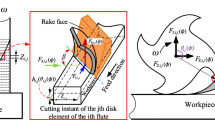Abstract
Residual stresses induced by machining coupled with the initial stresses can significantly impact mechanical properties of workpieces such as distortion, corrosion resistance, and dimensional stability. The redistribution pattern of residual stresses is extremely complex. The stress relieving can seriously deform the workpieces and reduce the fatigue life. Therefore, deflection prediction is critical for design, control, analysis, and management of machining. In this paper, an integrated modeling method is introduced to predict the deflection caused by milling residual stresses, to be more exact, to map the relationship between the deflections and the cutting parameters. Response surface design (RSD) is utilized to develop a new mathematical model which can predict the residual stress profiles of the workpieces along the cutting direction based on different cutting parameters. Then, the deflections are derived based on the estimated stress profiles and mechanics of materials theory. A finite element analysis model (FEM)-based simulation experiment using aluminum alloy 6061 as a case study has been implemented. The results from experiments indicate that the proposed approach could precisely estimate the residual stress profiles for given cutting parameters and effectively predict the deflections of the workpieces caused by residual stress.
Similar content being viewed by others
References
Afazov S.M., Becker A.A., and Hyde T.H., 2012, Mathematical modeling and implementation of residual stress mapping from microscale to macroscale finite element models, Journal of Manufacturing Science and Engineering, Transactions of the ASME, Vol. 134, No. 2, pp
Aijun T, Liu Z (2008) Deformations of thin-walled plate due to static end milling force. J Mater Process Technol 206(1–3):345–351
Andersen LF (2002) Experimental method for residual stress evaluation through the thickness of a plate. J Eng Mater Technol Trans ASME 124(4):428–433
Bishop J (2003) Rapid stress analysis of geometrically complex domains using implicit meshing. Comput Mech 30(5–6):460–478
Box GEP, Hunter JS (1957) Multi-factor experimental designs for exploring response surfaces. Ann Math Stat 28(1):195–241
Celano G, Castagliola P, Trovato E, Fichera S (2011) Shewhart and EWMA t control charts for short production runs. Qual Reliab Engng Int 27(3):313–326
Ding T, Zhang S, Wang Y et al (2010) Empirical models and optimal cutting parameters for cutting forces and surface roughness in hard milling of AISI H13 steel. Int J Adv Manuf Technol Vol. 51(No. 1):pp. 45
El-Khabeery MM, Fattouh M (1989) Residual stress distribution caused by milling. Int J Mach Tools Manuf 29(3):391–401
Fuh K, Wu C (1995) A residual-stress model for the milling of aluminum alloy (2014-T6). J Mater Process Technol 51(1–4):87–105
Guo YB, Ammula SC, Barkey ME (2006) A wet etching method coupled with finite element analysis-based compliance function to determine residual stress in high-speed milling. J Manuf Sci Eng Trans ASME 128(3):792–801
Kenda, Jani, Pusavec, Franci, and Kopac, Janez., 2011, Analysis of residual stresses in sustainable cryogenic machining of nickel based alloy - Inconel 718, Journal of Manufacturing Science and Engineering, Transactions of the ASME, Vol. 133, No. 4
Klamecki BE (1999) Residual stresses and workpiece deformation due to polishing and plating of computer hard disk substrates. J Manuf Sci Eng Trans ASME 121(1):32–40
Liu YM, Jiang ZL, Li Z (2012) A surface residual-stress model of optimizing milling parameters for milling aluminum alloy 6061. Adv Mater Res 426:7–10
Liu Y, Jiang Z, Li Z (2011) Impact of cutting parameters on surface roughness in milling aluminum alloy 6061 using ANN models. Appl Mech Mater 63–64:412–415
El-Axir MH (2002) A method of modeling residual stress distribution in turning for different materials. Int J Mach Tool Manuf 42(9):1055–1063
Mohammadpour M, Razfar MR, Jalili SR (2010) Numerical investigating the effect of machining parameters on residual stresses in orthogonal cutting. Simul Model Pract Theory 18(3):378–389
Aslan N (2008) Application of response surface methodology and central composite rotatable design for modeling and optimization of a multi-gravity separator for chromite concentration. Powder Technol 185(1):80–86
Research and Markets, 2013, Finite Element Analysis (FEA) Market in APAC Region 2012-2016, Available: http://www.researchandmarkets.com/research/9tkljf/fea_market_in
Salio M, Berruti T, De Poli G (2006) Prediction of residual stress distribution after turning in turbine disks. Int J Mech Sci 48(9):976–984
Schajer GS (1981) Application of finite element calculations to residual stress measurements. J Eng Mater Technol Trans ASME 103(2):157–163
Sun B, Wu Z, Chen Z (2010) Process parameter optimization of injection molding by combining RSM/GA method. China Mech Eng 21(9):1115–1118
Tang Z T., 2008, Residual stresses and deformations of aerospace aluminum alloy in machining. Doctoral dissertation. Shandong University
Tang ZT, Liu ZQ, Pan YZ et al (2009) The influence of tool flank wear on residual stresses induced by milling aluminum alloy. J Mater Process Technol 209(9):4502–4508
Thiele JD, Melkote SN (2000) Effect of tool edge geometry on workpiece subsurface deformation and through-thickness residual stresses for hard turning of AISI 52100 steel. J Manuf Process 2(4):270–276
Vasinonta A, Beuth JL, Griffith M (2007) Process maps for predicting residual stress and melt pool size in the laser-based fabrication of thin-walled structures. Trans ASME 129(1):101–109
Wetzel A, Karger L (2005) Two fe formulations for a rapid 3D stress analysis of composite sandwich structures. Sandwich structures 7: Advancing with Sandwich structures and materials, pp. 321-330
Yang X, Liu CR, Grandt AF (2002) An experimental study on fatigue life variance, residual stress variance, and their correlation of face-turned and ground Ti 6Al-4V samples. J Manuf Sci Eng Trans ASME 124(4):809–819
Yonetani Shigeru. Generation and Countermeasures, China Machine Press, 1983
Author information
Authors and Affiliations
Corresponding author
Rights and permissions
About this article
Cite this article
Jiang, Z., Liu, Y., Li, L. et al. A novel prediction model for thin plate deflections considering milling residual stresses. Int J Adv Manuf Technol 74, 37–45 (2014). https://doi.org/10.1007/s00170-014-5952-y
Received:
Accepted:
Published:
Issue Date:
DOI: https://doi.org/10.1007/s00170-014-5952-y



